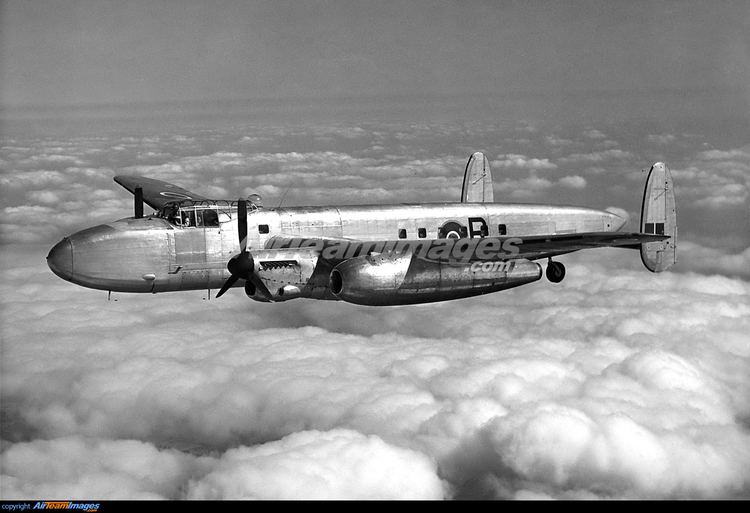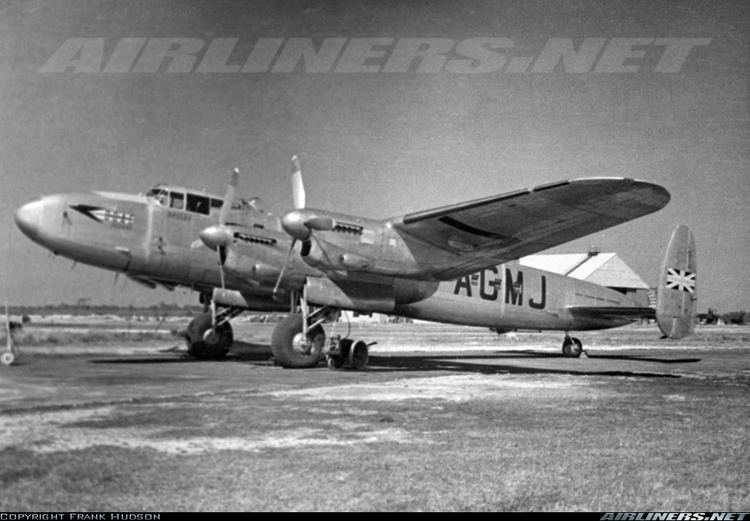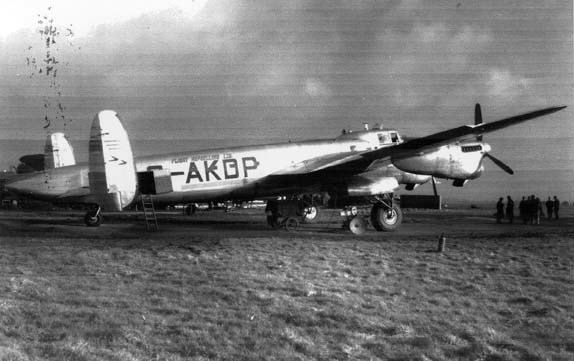Top speed 499 km/h Length 23 m Retired 1960 Manufacturer Avro | Wingspan 31 m Introduced 1945 First flight 1943 | |
 | ||
The Avro 691 Lancastrian was a Canadian and British passenger and mail transport aircraft of the 1940s and 1950s developed from the Avro Lancaster heavy bomber. The Lancaster was named after Lancaster, Lancashire; a Lancastrian is an inhabitant of Lancashire.
Contents
- Design and development
- Operational history
- Lancastrian engine testbeds
- Star Dust
- Variants
- Civil Operators
- Military Operators
- Specifications Lancastrian C1
- References

The Lancastrian was basically a modified Lancaster bomber without armour or armament and with the gun turrets replaced by streamlined metal fairings, including a new nose section. The initial batch was converted directly from Lancasters; later batches were new builds.

Design and development

In 1943, Canada's Victory Aircraft converted a Lancaster X bomber for civil transport duties with Trans-Canada Airlines (TCA). (After the war Victory Aircraft was purchased by what became Avro Canada). This conversion was a success resulting in eight additional Lancaster Xs being converted. The "specials" were powered by Packard-built Merlin 38 engines and featured a lengthened, streamlined nose and tail cone. Range was increased by two 400 gal (1,818 L) Lancaster long-range fuel tanks fitted as standard in the bomb bay. These Lancastrians were used by TCA on its Montreal–Prestwick route.

The modification of abundant military aircraft into desperately needed civil transports was common in the United Kingdom in the immediate postwar period: the Handley Page Halton was a similar conversion of the Halifax heavy bomber.
Operational history

In 1945, deliveries commenced of 30 British-built Lancastrians for BOAC. On a demonstration flight on 23 April 1945, G-AGLF flew 13,500 mi (21,700 km) from England to Auckland, New Zealand in three days, 14 hours at an average speed of 220 mph (354 km/h).
The Lancastrian was fast, had a long range, and was capable of carrying a heavy load, but space inside was very limited as the Lancaster had been designed with space for its seven crew dispersed throughout the fuselage, and the 33 ft (10.05 m) long bomb bay. Consequently, it was not suited to carry large numbers of passengers, but was suitable for mail and a small number of VIP passengers. BOAC used it for flights between England and Australia from 31 May 1945. It also served with the RAF; RAF Lancaster I serial number PD328, was converted to a Lancastrian and renamed Aries, as well as serving with QANTAS and Flota Aérea Mercante Argentina.
Lancastrians were used during the Berlin Airlift to transport petrol; 15 aircraft made over 5,000 trips. In 1946 a Lancastrian operated by BSAA was the first aircraft to make a scheduled flight from the then-newly opened London Heathrow Airport.
Lancastrian engine testbeds
Data from:
With the advent of gas turbine engines there emerged a need to test the new engines in a controlled flight environment in well instrumented installations. An ideal candidate emerged as the Avro Lancastrian which could easily accommodate the test instrumentation as well as fly on the power of two piston engines if required. Several Lancastrians were allocated for engine test-bed work with turbojet engines replacing the outer Merlin engines or test piston engines in the inner nacelles. Fuel arrangements varied but could include Kerosene jet fuel in outer wing tanks or fuselage tanks, with AVGAS carried in remaining fuel tanks.
"Star Dust"
On 2 August 1947 Lancastrian G-AGWH Star Dust of British South American Airways was lost in the Argentine Andes, whilst en route from Buenos Aires, Argentina, to Santiago, Chile. The probable cause of the crash was a navigation error due to the then-unknown effect of the fast-moving jetstream.
Variants
Civil Operators
Military Operators
Specifications (Lancastrian C.1)
Data from
General characteristics
Performance
